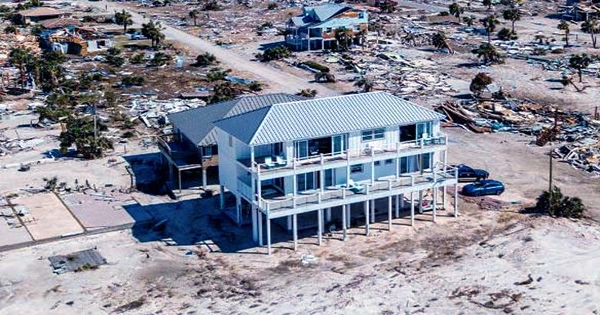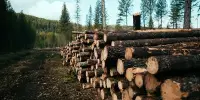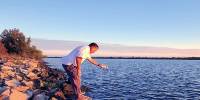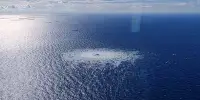Alaska’s FAIRBANKS — As the remains of Typhoon Merbok raged through the Bering Sea on Saturday, communities along Alaska’s western coast experienced significant flooding. Wind gusts tore the siding off houses, and a storm surge pulled dwellings away from their foundations.
As the storm moved over the state from south to north, its effects were felt along hundreds of kilometers of shoreline. Roaring seas in Nome flooded six downtown streets, including a portion of Front Street, which is close to where mushers finish the Iditarod sled-dog competition. Images from Chevak, 200 kilometers to the south, showed sheds swaying in the waves adjacent to fallen ships.
Dean Peterson said that water had overrun the 20-foot berm protecting the 170-person village of Golovin, about 70 miles east of Nome, and had rushed through the lower-lying sections, tearing three homes from their foundations and wrecking another.
People in the neighborhood rushed to save an elderly man from his home, while many others fled and sought refuge in the school, which was insufficiently fortified.
The institution, according to Mr. Peterson, is totally encircled by water. He claimed he was unaware of any injuries.
The storm surge had inundated many roads, sending debris and driftwood into town, but Nome’s mayor, John Handeland, claimed there had been no reports of injuries in his village. One beachfront road was at least partially washed away, while the seas swept away an abandoned house.
It will take a few days before we can fully assess the extent of the damage, he said.
According to the National Ocean Service, a part of the National Oceanic and Atmospheric Administration, water levels were seven to nine feet over average on Saturday morning in Nome, a town with a population of fewer than 10,000.
According to National Weather Service representatives in Alaska, coastal flood advisories were still in place in some places as of Sunday morning. According to them, water levels in the Koyuk region, 130 miles east of Nome, could still rise 12 to 18 feet over usual tide lines.
Editor’s Choice
Gua Sha, dry brushing, and body scraping are all popular lymphatic health practices.
How to Prepare Your Life’s Best Miso Soup
The Faces That Return to Us When We Come Out, Time and Time Again
With waves reaching a height of 50 feet on Friday north of the Aleutian Islands, forecasters said the storm was one of the most potent systems to travel through the Bering Sea area in decades. Wind gusts that were nearly hurricane-force were experienced by many towns.
The strength of the storm was undoubtedly influenced by global warming, according to scientist Brian Brettschneider of Anchorage. Because sea temperatures are often too cold for tropical cyclones to form, the rapid formation of storms thus far north is unusual, according to him.
There is a compelling case for believing that climate change shifted the odds in favor of this storm, he said.
According to Mr. Brettschneider, the sea surface temperatures measured along Alaska’s western coast were at or very close to records. It’s logical to believe that these kinds of storms will occur more frequently because, as he explained, “climate change will enhance the possibility that all these ingredients will be in place at the same moment.”
Local, state, federal, and tribal emergency personnel were evaluating the situation and getting ready to deploy. Many of the settlements in the area have small populations of a few hundred or less, and they are not connected by roadways, making it difficult to provide a comprehensive response.
The state’s Division of Homeland Security and Emergency Management has not yet received any emergency requests or reports of fatalities or injuries, according to Jeremy Zidek, a spokesman for the organization.
People were given ample warning and took numerous safety precautions, he claimed.
The extent of the flooding-related damage, according to Mr. Zidek, won’t be determined until Saturday. Communities can typically only go out and conduct a full inspection after a day or two, he said. Sometimes it’s obvious, sometimes it seems little, but it’s actually more serious.
Travis Kaningok reported that he and some other volunteers had spent Friday night and Saturday morning constructing a temporary sea wall out of gravel and sandbags on Gambell, on St. Lawrence Island, roughly 200 miles west of Nome. For the village, which consists of about 500 people, they had also kept an eye on the waves throughout the night.
He remarked, “These waves are unlike anything I have ever seen before, going against the wind and getting bigger by the minute.
The aviation runways that were utilized to deliver commodities to specific towns also presented significant logistical challenges for the days to come; images from Saturday showed that some of them appeared to be submerged.
On Saturday morning, Gov. Mike Dunleavy posted on Facebook that he had orally declared a disaster for the storm-affected areas. If necessary, the Alaska State Troopers stated that they will help with search and rescue operations.
A resident of Hooper Bay, west of Chevak, named Angivran Joe reported that a property in the area damaged by the storm surge had been blown off its foundation and that a home across the street from it had started to crumble. He stated that many individuals were still without electricity after the storm knocked out power and that some were now using generators. Some fuel tanks had also toppled over.
















